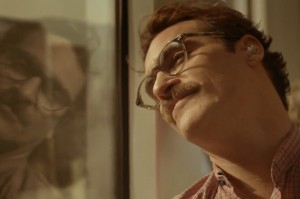Richie Feathers, Arts Editor
It had an entirely original script and a roster of mesmerizing actors, but what made “Her” such a celebrated film of 2013 was its achingly real love story. The only catch: it was between a man and his operating system.

Set in a near-future city, the movie follows Joaquin Phoenix’s Theodore, a quiet, professional letter writer going through the final stages of divorce. He’s sentimental but lonely, content with a routine, but striving for something new. So he jumps at the opportunity to test out a new device called OS1–it’s slogan: “It’s not just an operating system, it’s a consciousness.” But what Theodore doesn’t anticipate is that this innovative piece of technology is inhabited by a free-thinking, ever-evolving and always-endearing voice named Samantha (a revelatory Scarlett Johansson). She scans his files, chooses her favorite letters of his and offers just what he needs: a unique companionship.
For all of its stunning features, be it Arcade Fire’s Oscar-nominated score or the fluidity of each camera shot, “Her” also offers a startling glimpse into our not-unlikely future. People still roam the streets, but never together, communicating instead to pieces placed in their ear. It’s neither a utopia nor a dystopia, it’s merely a continuation of the 21st century.
Samantha not only provides Theodore with conversation, she also possesses the ability to read the tone of his voice–she knows when something is wrong, when he is particularly happy and when he doesn’t want to talk. And as the movie progresses we begin to forget that Samantha is not actually a human on the other end of a telephone line. This adds to the impact that “Her” eventually rewards us with.
One trait of Theodore that is both refreshing and relatable is that he is not an especially awkward character. While he could benefit from socializing more or being more adventurous, he is still a likely individual to represent us all. He is just a victim of his time, where people remain mysterious but are content to solely coexist with one another. His world is one where hearing a human voice is a commodity, particularly one as lively as Samantha’s. But in a way, this is our world too. Our words and exchanges are black and white, printed on a screen and emotionless. We have good intentions but physically speaking to someone else is no longer the obvious choice.
So for Theodore to fall in love with Samantha is both organic and sincere. When he tells his friend Amy (a subtly brilliant Amy Adams) that he has fallen in love with his operating system, she is more intrigued than judgmental, revealing her shared connection with her own OS1. This portrayal of our future is one where technology has integrated itself deeper into our society, where it thinks and acts for itself. “Her” expresses a future where we have injected our “Siri”s with human qualities and allowed ourselves to carry on, thinking they’re like us. Yet, they’re not.
When Samantha asks Theodore, “How do you share your life with somebody?,” she’s both inquisitive because she actually doesn’t understand and confused because she sees herself as an individual being. It’s a beautiful moment in the film because it reaches past Theodore and out to us. So we must too ask ourselves, “How do we share our life with somebody else?” The answer goes beyond sending a selfie or updating a status; it requires that we look to where we are heading.
Technology is a wonderful part of our lives but it’s never stagnant. It intertwines with our unique moments of personal isolation, demanding we share the space with someone else. Technology asks too much of our privacy because the devices will never understand how it feels to have it.
Leave a Reply